
views
Cutting Thin-Gauge Steel and Sheet Metal
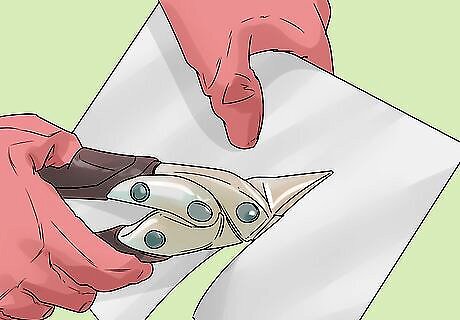
Use compound snips to make small cuts in thin-gauge steel. Compound snips are sometimes referred to as “aviation snips” or “tin snips.” These scissor-like tools allow you to cut through thin steel – 24 gauge or thinner – in the same way you would cut through paper with ordinary scissors. Snips are a good choice if you need to make quick, short cuts on very thin steel. There are three kinds of compound snips, with color-coded handles to make them easy to tell apart. Straight snips have yellow handles and allow you to cut straight lines. Left-cut snips have red handles and allow you to cut counter clockwise curves. Right-cut snips have green handles and allow you to cut clockwise curves.
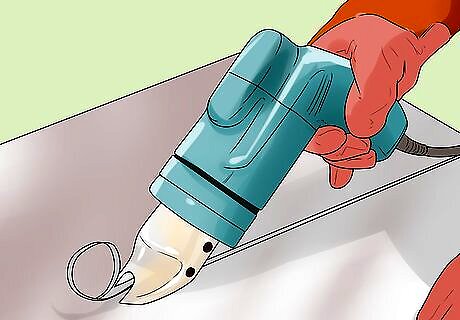
Choose a nibbler to make longer cuts in thin-gauge steel. Compound snips work great for short cuts, but longer cuts are best handled by a nibbler. Nibblers are hand-held tools. They are relatively inexpensive and make clean, high-speed cuts with minimal distortion and very little noise. They also create no sparks when cutting. Thicknesses vary from brand to brand, but in general a nibbler can cut up to 14 gauge steel. There are hand-operated, drill-powered, electric and pneumatic versions on the market. Every time the nibbler makes a cut, it punches out a small piece of sheet metal. By the time you’re finished, you’ll have many tiny crescent-shaped steel pieces littered all over the floor. Definitely clean those up as soon as possible – otherwise, the sharp little edges can get embedded in the soles of shoes and cause injuries.
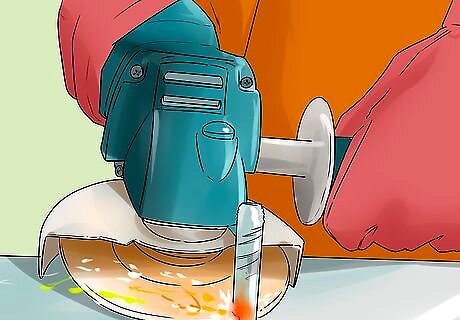
Use an angle grinder fitted with a metal cutoff wheel for rough cuts. An angle grinder is an affordable handheld power tool that can handle many different grinding and cutting tasks. It can be fitted with an assortment of different blades, which makes it very versatile. The blade you need to use in order to cut through steel is called a metal cutoff blade. You can make fast cuts with the cutoff blade, but the downside is they will be fairly rough. It’s difficult to get perfect accuracy with this tool. Wear face protection, ear protection (it’s very loud) and thick work gloves when operating this tool. Sparks will fly when the blade touches the metal, so make sure there’s nothing flammable nearby. Make sure you read the instruction manual carefully and are using the correct blade for cutting steel.
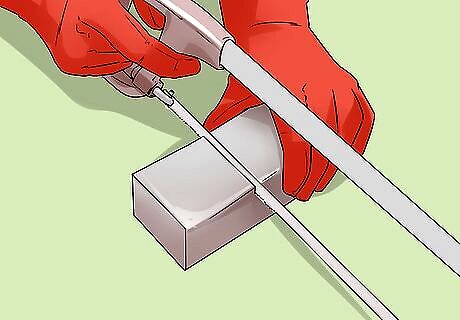
Use a hacksaw for simple, shallow cuts. A hacksaw can cut through sheet metal, but its shape limits the types of cuts it can make. The cuts may also be a bit rough, you won’t be able to maneuver the saw much and its blade can’t cut very deep. However, a hacksaw is great tool to have on hand to take care of simple steel-cutting tasks. Keep its blade in good condition by rubbing wax on it after each use. To get a cleaner cut, try using a strip of masking tape on the bottom and top of the sheet metal. This will prevent scratching.
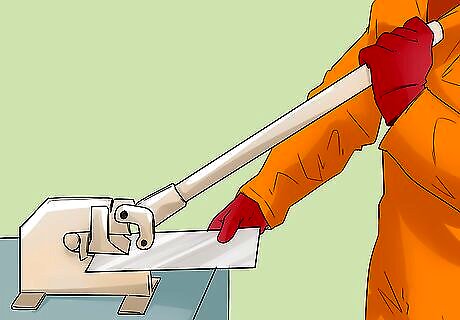
Use a bench shear to easily cut most gauges of sheet metal. Bench shears come in two general types: straight shears and throatless shears. Straight shears make cuts that are straight lines. Throatless sheers can cut inside curves and other complicated shapes, in addition to outside curves and straight lines. They look and operate much like office paper cutters. A lever fitted with a blade is pulled down over the place you want to cut. To operate, mark the cut line on the piece of sheet metal. Situate the metal under the blade and line the blade up with the cut line. Pull the handle down slowly with your hand and slice through the metal.
Cutting Thicker Steel with Power Saws
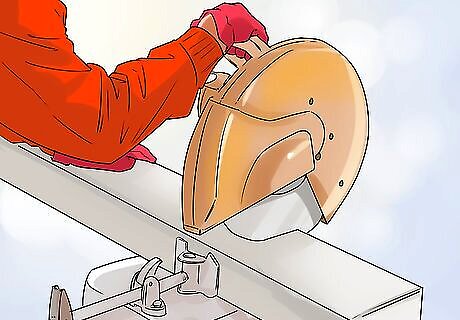
Use an abrasive chop saw for accurate square cuts. A chop saw is an efficient, heavy-duty circular saw. It is supported by a metal base and mounted on a pivoting arm, making it very easy to use. A chop saw can handle a lot of different steel-cutting duties and is able to make exact, square cuts. It’s an affordable tool, making it more realistic than the horizontal saw or cold saw for a home shop setting. However, it can’t make cuts as accurate as either of those tools can. Chop saws are high-powered. A great deal of heat is generated during the cut, making the steel extremely hot. Handle freshly cut steel with caution. Along with heavy-duty gloves and eye protection, you need to use ear protection when operating power saws. They are very loud and can damage hearing.
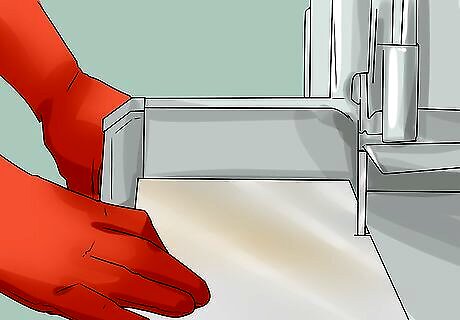
Use a horizontal band saw. Band saws are fairly economical and can cut thicker steel with more accuracy than the abrasive chop saw. They are very easy to use – all you have to do is feed the metal into the saw and the blade does the rest. Make sure you’re using metal-cutting (carbon steel or bimetal) blades with your band saw. There are three main blade tooth patterns – raker, wave and straight. For cutting steel thicker than sheet metal, use the raker pattern. For thinner steel, use the wave tooth pattern. The blades get dull easily and need to be replaced to get proper accuracy. Band saws cut slowly and you may need to grind minor rough edges off after the cut is made. Band saws have a higher capacity than cold saws, but they don’t cut as accurately.

Make highly accurate cuts with a cold saw. A cold saw is a very expensive piece of equipment and generally isn’t a realistic choice for a home shop setting unless you plan on using it often. Cold saws make clean cuts that are more accurate than what a band saw can do, but a cold saw’s capacity is smaller. If you’re trying to choose between the two, make your decision based on how much steel you need to cut and how accurate you need to cut it. The cold saw is circular and its blade has a lot of teeth. The blade itself spins very slowly, but the cut is made quickly. A coolant is used with the cold saw to prevent the steel from heating up. The coolant should be immediately wiped off the steel after the cut is made.
Using Torches

Take the proper safety precautions for torch use. Torches give off intense heat and light. When you use them to cut through steel, they also throw off sparks, which makes them a fire hazard. It’s imperative that you wear welding gloves and shaded eye protection in the shade range of #7 to #9. Wear a protective jacket or apron used by welders. Don’t wear pants made of natural fibers and make sure they’re not cuffed (the sparks can get trapped in cuffs). Make sure you don’t have any loose clothing, and if you have long hair, have it up in a ponytail or a bun. Work in a well-ventilated room and, if necessary, wear a respirator. Make sure there’s nothing flammable in the immediate vicinity, since the sparks could ignite the material.
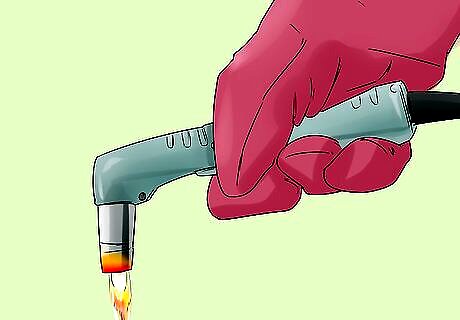
Use a plasma torch for metal that is 0.25-inch and thinner. A plasma torch is a relatively inexpensive, high-powered tool that slices through steel using a thermal cut process. It’s ideal for metal that is 0.25-inch and thinner. These torches won’t warp thin metal, whereas the oxy-fuel torch might. Plasma torches make very clean cuts and are extremely efficient. A plasma torch can cut through any conductive material, not just steel. The oxy-fuel torch is only able to cut steel.
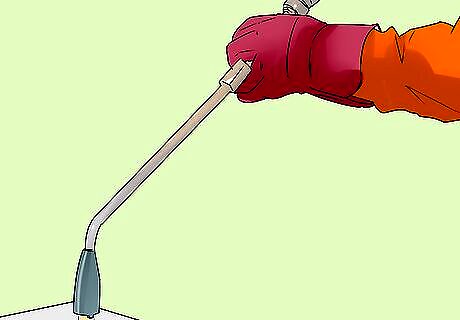
Use an oxy-acetylene torch to cut through thick steel plates. Oxy-fuel torches cut through far thicker materials than plasma. Use oxy-fuel to cut through any steel thicker than 1 inch (2.5 cm). It’s possible for an oxy-fuel to cut through up to 48 inches (120 cm) of steel. Steel plates, however, are usually 12 inches (30.5 cm) thick or less. Oxy-fuel torches make cuts with a smooth, square cut surface. Do not use oxy-fuel torches around oil or grease. High-pressure oxygen tanks can react violently with them. Acetylene is also a dangerous gas to work with. It is unstable over 15 psi, so try to keep it around 5 psi during use. Always store these tanks upright.



















Comments
0 comment